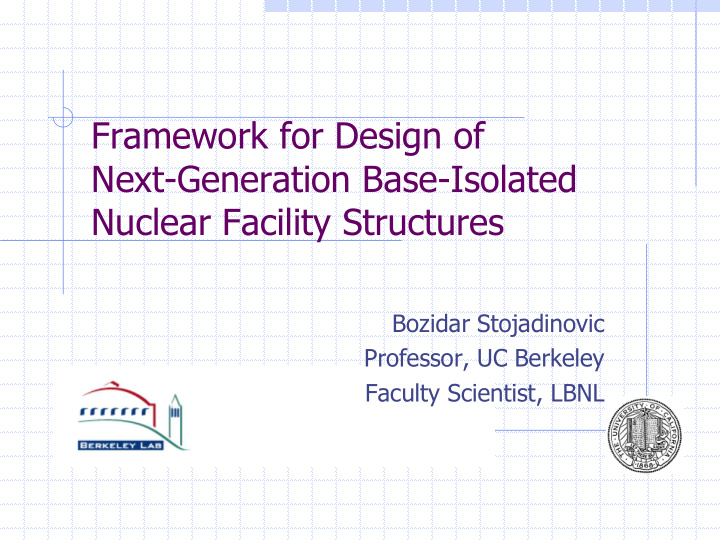



Framework for Design of Next-Generation Base-Isolated Nuclear Facility Structures Bozidar Stojadinovic Professor, UC Berkeley Faculty Scientist, LBNL
Next-Generation Nuclear Power Plants Small Modular Reactors: Less power, smaller size, smaller weight Passively safe Cooled by means other than water Different fuel design: Smaller source term Compact fuel management Proliferation-resistant Easier to store/reprocess
Next-Generation Nuclear Power Plants Economic case: Build many essentially identical power plants Enable a series of small investments Fit the existing grid Located at many more sites: Higher hazard exposure Different soil conditions
New Designs: Feature Seismic Isolation Toshiba 4S GE PRISM
Seismic Isolation Concept
Dynamics of a Seismically Isolated System Kelly, 1990
Period Elongation and Damping Buckle, et.al, 2006
Seismic Isolator: Laminated Rubber Bearings Technology developed in 1980’s Used in buildings and but safety- critical structures: LNG tanks Hospitals Emergency command centers Considered for PRISM and SAFR
Seismic Isolator: Friction-Pendulum Bearings Technology developed in 1990’s Used in conventional building structures Used in critical infrastructure: San Francisco Bay Area long-span bridge crossings Off-shore platforms
Seismic Isolator Behavior: Normal and Design Basis Loads Buckle, et.al, 2006
Seismic Isolator Behavior: Beyond Design Basis Loads FPS LRB Mosqueda, et.al, 2004 Kukuchi et.al, 2010 Fenz and Constantinou, 2008
Seismic Design Basis NRC design basis: Annual mean seismic CDF: 10 -6 Annual mean FOSID: 10 -5 ASCE 43-05, Section 1.3: Given (modified) UHRS (MAF 10 -4 ) design such that: Less than 1% probability of unacceptable performance for the Design Basis Earthquake (DBE) ground motion Less than 10% probability of unacceptable performance for a ground motion equal to 150% of the DBE ground motion
Unacceptable Performance: Isolated NPP Target performance of the system: ASCE 43-05: SDC 5D for SSCs Isolated superstructure is expected to remain essentially elastic: Reduced horizontal accelerations Lesser of equal vertical accelerations Smaller non-structural demands Foundations are expected to remain elastic Applies to all but the isolation system
Unacceptable Performance: Seismic Isolators Exceeding horizontal deformation capacity Rubber tearing in shear FPS bearings hitting the rim Exceeding vertical deformation capacity Rubber tearing in tension FPS bearing disassembling Loss of stability in compression Buckling Roll-out Failure of isolator attachments
Unacceptable Performance: Isolation System Impact of the isolated structure: Horizontally, against adjacent structures or surrounding soil Vertically, due to uplift caused by: Vertical excitation Overturning/rocking Resulting in high-frequency excitation of the isolated super-structure and its content
Unacceptable Performance: Isolation System Local failure of the foundation or isolation diaphragms: Excessive deformation leading to isolator deformation or load redistribution Inability to redistribute loads in case of single isolator failure
Acceptance Criteria (ASCE 4) 1. Individual isolators shall suffer no damage in DBE shaking 2. The probability of the isolated nuclear structure impacting surrounding structure is: 1% or less for DBE shaking 10% or less for 150% DBE shaking 3. Individual isolators shall sustain gravity and earthquake-induced axial loads at a displacement larger or equal to 90th percentile lateral displacements consistent with 150% DBE shaking Whittaker and Huang, for ASCE 4
Satisfying Acceptance Criteria Criteria 1: by isolation device design and production-testing of individual isolators ASCE 4 adopts a standard test protocol Criteria 2: by analysis, given a best-estimate isolator, structure and soil model as well as ground motion representation ASCE 4 response amplification: 3x the median DBE response Criteria 3: by prototype-testing of a limited number of isolators and by analysis Whittaker and Huang, for ASCE 4
Role of SSI Analysis: Ground Motion Specification Seismological aspects: UHRS and record selection for response frequencies of interest: Horizontal 0.2 to 0.5 Hz Vertical 2 to 20 (or more) Hz Effect of local soil response on horizontal and vertical excitation Wave propagation: Ground motion component coherency Near-field effects Rotation components (rolling)
Role of SSI Analysis: Local Soil Response Foundation and soil deformability: Short term, under extreme loads Long term Ability to transmit ground motion into the structure: Foundation-soil interface Static and dynamic stability of slopes: Isolation moat Structures partially or completely under ground Soil and slope behavior under impact
Role of SSI Analysis: Interaction Itself Interaction between the soil, foundation, seismic isolation, and the isolated structure: Three-dimensional Inherently non-linear Integrated Crucial for assessment of isolation system performance: Seismic isolation needs better SSI
SSI Analysis Challenges Integrated, non-linear time-domain modeling of the isolated structure and the surrounding soil Include non-linear seismic isolator models Verification and validation in the response ranges of interest Speed and user interface suitable for production runs
Benefits of Seismic Isolation Seismic isolation technology is mature and ready for NPP application Reduces seismic risk: Response is more predictable Performance characteristics of SSCs in a seismically isolated NPP are better Facilitates standardization: Reduces cost and time to build May simplify design and regulatory review
Thank you! This work was performed under the auspices of the U.S. Department of Energy by the University of California, Lawrence Berkeley National Laboratory under Contract DE-AC02-05CH11231. This project, known at NRC as project #N6509, was supported by the U.S. Nuclear Regulatory Commission under a Federal Interagency Agreement with DOE.
Recommend
More recommend